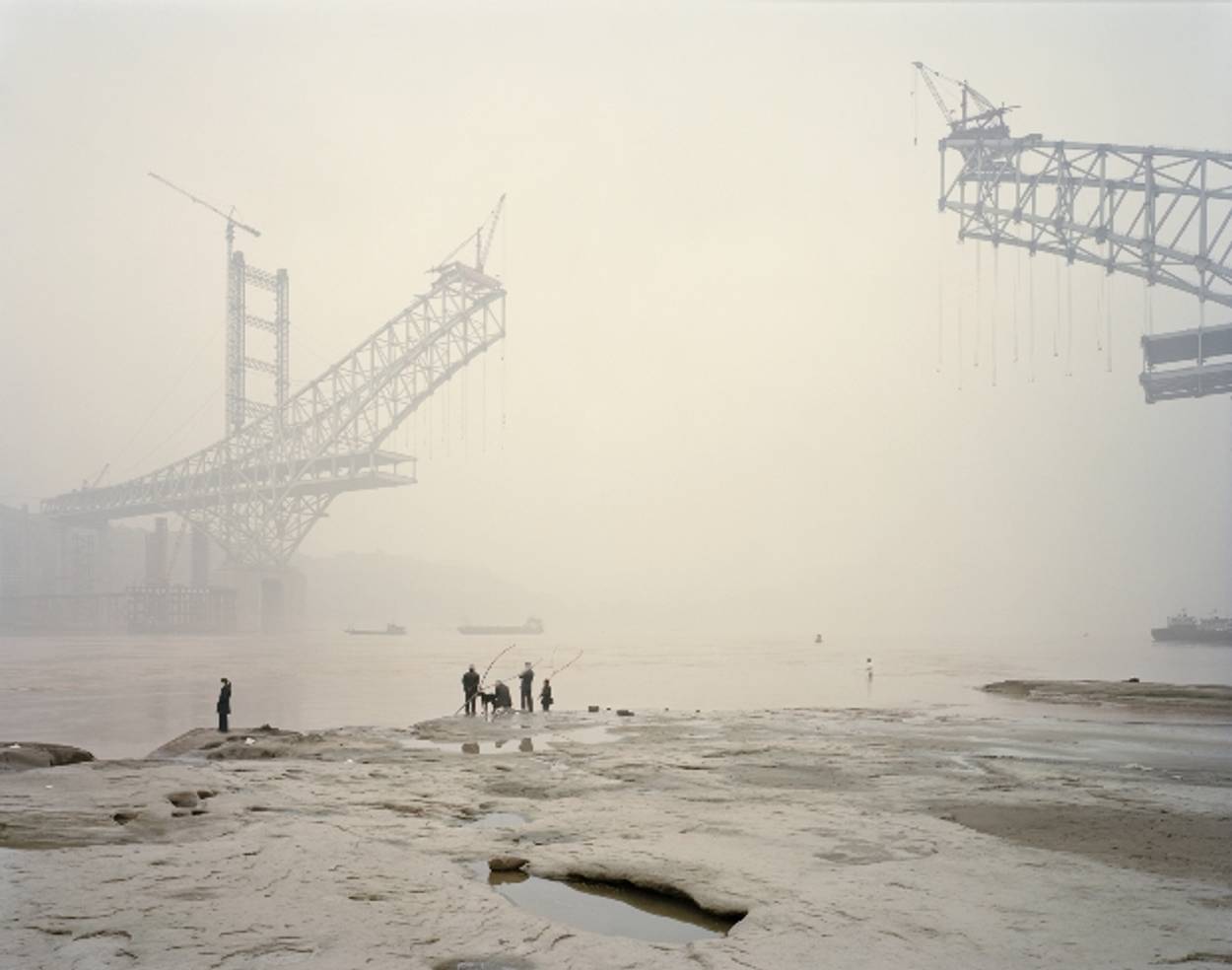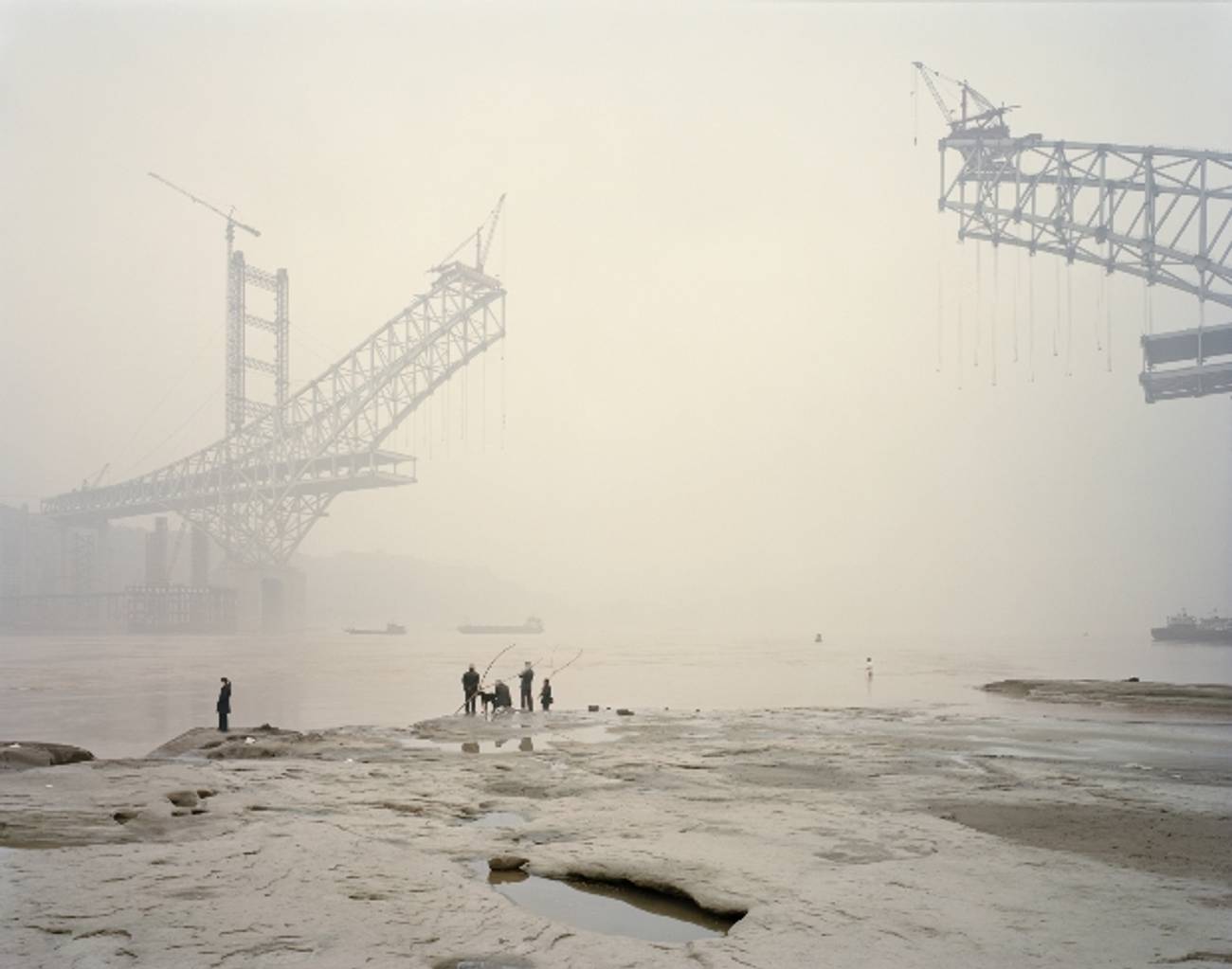Ebb and Flow
Israeli-born photographer Nadav Kander traveled China’s Yangtze river to chart the country’s transformation. He brought back a meditation on universal change.




What do the election of President Barack Obama and the construction of China’s Three Gorges Dam have in common? Both were colossal ideas of governance meant to redirect the flow of a central feature of a nation and bring power to 350 million people. Both were also memorably documented by the Israeli-born photographer Nadav Kander, whose sensitivity to the human impact of sweeping change is at the heart of his gorgeous new monograph, Yangtze: The Long River, published this year by the Stuttgart-based Hatje Cantz fine art press. Billed as “authentic images of China’s leap into a new era,” they also obliquely recall our own march into the future, two years ago this January.
In the heady days at the end of 2008 and early 2009, the New York Times Magazine hired Kander, an accomplished editorial and fine art photographer, to produce “Obama’s People,” a portfolio of spare, flatly lit individual portraits of 52 members of the president-elect’s transition team. Kander and Times photo director Kathy Ryan called it an “athletic” challenge to corral Obama staffers into shoots in Washington and Chicago as they plowed into executive office at full throttle. All but the most seasoned Washington hands (Clinton, Pelosi, Biden) look rumpled, harried, and disheveled, which is partly Kander’s portraiture style and partly due to the palpable post-election giddiness. Rahm Emanuel, Kander recalls, burst onto the set, shook hands with everyone, said, “Well, this is like my bar mitzvah,” stood for a portrait that accentuates his raccoon-like eye sockets, then barreled out of the hotel conference-room lobby to things that at the time seemed vitally important. “He will be Obama’s chief of staff,” reads the caption to the image showing Emanuel with his suit jacket spread wide as if reaching for holstered six-shooters.
Kander’s images of China along the Yangtze are just as athletic, in their own way: 77 plates shot during five trips in three years from 2005 to 2007. He worked against the current, from the mouth near Shanghai—40 miles wide, the Pacific ocean’s largest pollutant, shuttling 10,000 ships a day—to its source in western Qinghai province, over the Three Gorges. By evidence of what’s on view, Kander slogged through tidal mud, rambled in construction sites, climbed abandoned buildings, trekked to remote frozen banks, and waited under invariably hazy skies for a scene to empty of locals or boats and repopulate in a compositionally sound manner. Despite the apparent difficulty in getting to these vantage points, the mood in the photos is, by Kander’s own admission, contemplative, as if the eighth-century Chinese poet Du Fu were back composing lyrics to the river and its power to make humans seem puny and vain. “Fluttering from place to place,” wrote Du Fu, “I resemble/ A gull between heaven and earth.”
In modern China, though, where man has worked for millennia to dominate nature, often razing just to rebuild a semblance of what was already there, the power of the 4,100-mile Yangtze to make our aspirations seem small is further heightened in these photographs by the scale of the state’s new infrastructural ambitions. Where Kander confined Obama’s people to a tiny space, the better to humanize their larger-than-life personas, in China, the photographer steps further and further away from the Chinese—leaving them lost and diminished in frames with unbroken horizon lines and towering half-finished constructions: bridges, sea walls, apartment blocks, the world’s largest hydroelectric plant, the flooded Wu Gorge, and the snowy deserts of Qinghai.
Kander left Israel as an infant, following his father, an El Al pilot who, having lost his left eye, found himself forced to reinvent a life in South Africa. There, Kander received a Pentax camera for his bar mitzvah. His required South African national service landed him in an Air Force darkroom, developing and printing aerial pictures for two years in the early 1980s, and many of his landscapes of the Yangtze (and, in previous work, of the Arctic Circle, Los Angeles highway overpasses, the Jordanian desert, the American West, and Chernobyl) still retain a sense of floating or weightlessness.
In these terrifying but aesthetic landscapes, where supertankers can seem like bath toys, Kander finds small scenes of Chinese domestic life, or at least evidence of it having been lived. A man fishes in an inner tube in the pond-like calm of the dammed river, which once would have been so turbulent that elaborate rope tows were the only way upstream. Families gather under huge highway pylons for riverside tea and cards on a hot, lazy Sunday in the megacity Chongqing, chairs and tables set out on what viewers realize is the rubble of demolished housing. Clotheslines, tattooed bathers, solitary construction workers, empty chairs, nappers, and other ghostly remnants of human presence give the vastness scale but provide little comfort.
Kander calls this “simple domesticity pitted against the hugeness of our ideas” an echo of early 19th-century painters Caspar David Friedrich and J.M.W. Turner, whom he cites as sources. The Romantic lesson fits China’s assault on nature, as it does, in a way, Kander’s native Israel, too. In Yangtze, Kander sees “a people scarring their country, and a country scarring its people,” and though nothing in Israel’s public works comes close to the scale of the 1.8 million people displaced by the Three Gorges Dam—save for the project of statehood itself—Israel retains a similar conundrum of being rooted in a land that seems always a work in progress. This is also, not coincidentally, how Kander, who lives in England, describes himself.
Kander likes to say that his photographs can never be taken again, and he is right. (Rahm Emanuel, for one, has moved on.) But capturing a moment is, after all, the work of photography. As much as time is every photographer’s subject, so must change be its corollary. What Kander is interested in is the agent of change and the self-deception and hubris that fools us into thinking we are masters of it. Anyone or anything—China, Israel, Kander’s boyhood South Africa, Obama—seeking to subdue the forces of man or nature with projects on a super-human scale would do well to first observe the hazy pall over the banks of the Long River. As Kander makes clear, it has seen change you wouldn’t believe.
Matthew Fishbane is a senior editor at Tablet Magazine.
Matthew Fishbane is Creative Director at Tablet magazine.